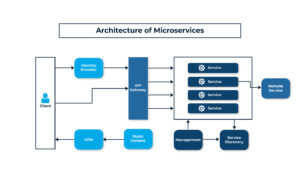In the world of software development, new trends constantly reshape how we create, deploy, and manage applications. One such powerful trend is the adoption of Microservice Architecture. This approach has become an important aspect of software development practices due to its ability to enhance agility, scalability, and autonomy. In this article, we will explore the growth and integration of microservice architecture and its significance within the realm of the Internet of Behavior.
How Microservices Architecture can benefit DevOps?
Microservices, often seen as the building blocks of software development, introduce an approach by emphasizing the creation of functional modules, each with unique operations and interfaces. This architectural style offers a more dynamic and agile approach to developing, executing, and managing applications by working with modular components versus a monolithic build. By breaking down applications into small, independent functions, it allows developers to rapidly build applications, add new features, or launch new services.
Architecture of Microservices:
6 Benefits of Microservices Architecture:
1. Flexibility and Independence:
Being nimble and adaptable is a pursuit of organizations, as DevOps methodologies become significant. Microservice architecture effectively responds to this need by offering loosely connected services. This empowers development teams to quickly conceive and maintain services, facilitating improvements and updates.
2. Isolation of Faults and Resilience:
In stark contrast to conventional monolithic applications, where a singular malfunction could trigger a cascading failure, microservices introduce fault isolation. If a single microservice encounters an issue, it doesn’t entail the collapse of the entire application as long as preceding services are engineered to manage glitches effectively. This augments the overall robustness of the system.
3. Seamlessly Orchestrated Updates:
Microservice architecture simplifies the process of implementing updates. With each service being distinct and autonomous, developers gain the ability to modify and administer individual services without the need to reconstruct and redeploy the entire application. This curtails downtime and mitigates disruptions during updates.
4. Diminished Interdependencies:
Navigating the intricacies of dependency poses a substantial challenge in software development. Microservices deftly address this by evading shared data repositories or codebases. This not only streamlines the assimilation of novel features but also fosters immaculate, modular code.
5. Microservices and Scalability: A Symbiotic Nexus
As we gaze toward the future of software development, the symbiotic association between microservices and scalability becomes increasingly conspicuous. The ascendancy of microservices harmonizes seamlessly with the call for scalable solutions that guarantee uninterrupted availability and formidable security. A noteworthy catalyst for this synergy is Kubernetes, an open-source container orchestration platform that propels the adoption of microservices and containers to loftier heights.
6. Kubernetes: The Vanguard of Orchestration
Kubernetes emerges as a pivotal instrument, empowering organizations to adeptly manage containers, construct microservices architectures, and mechanize the software deployment pipeline. Its role as an enabler of scalability, coupled with the inherent agility of microservices, forges a dynamic solution to surmount the challenges posed by the Internet of Behavior.
Conclusion
The unceasing expansion and assimilation of microservices architecture mirror a more comprehensive paradigm shift in the software development domain. As organizations endeavor to synchronize with the tenets of agility, fault tolerance, and scalability, microservices proffer a robust framework. Paired with the orchestration prowess of Kubernetes, this architectural paradigm navigates the terrain of the Internet of Behavior—a realm where user interactions and data insights coalesce. Harnessing the potential of microservices not only propels software development forward but also lays a sturdy foundation for the technologies that lie beyond.






